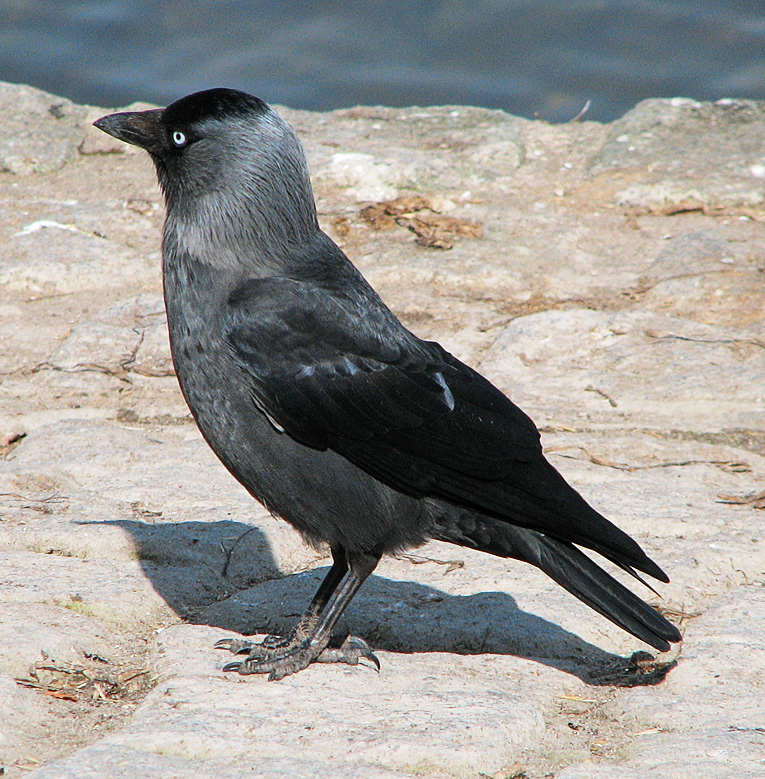|
| 질의: Green peacock | 결과: 72번째/72 | |
Jackdaw (Corvus monedula) - Wiki
| 제목: | Jackdaw (Corvus monedula) - Wiki
| |

| 해상도: 765x779
파일크기: 354427 Bytes
등록시간: 2007:12:03 10:24:24
|
Jackdaw
From Wikipedia, the free encyclopedia
Order: Passeriformes
Family: Corvidae
[Photo] Dohle / Jackdaw (Corvus monedula). Date: 24. Februar 2006. Photo by http://de.wikipedia.org/wiki/Benutzer:Darkone
The Jackdaw (Corvus monedula), sometimes known as the Eurasian Jackdaw or European Jackdaw, is one of the smallest species (34???39 cm in length) in the genus of crows and ravens.
Description
Most of the plumage is black or greyish black except for the cheeks, nape and neck, which are light grey to greyish silver. The iris of adults is greyish white or silvery white, the only member of the genus outside of the Australasian region to have this feature. The iris of juvenile jackdaws is light blue. The bird is sociable, moving around in pairs (male and female) or in larger groups, though the pairs of birds stay together within the flocks.
Distribution and habitat
Jackdaws are found over a large area stretching from North West Africa through virtually all of Europe, Iran, north-west India and Siberia, where they inhabit wooded steppes, woodland, cultivated land, pasture, coastal cliffs and villages and towns.
Behaviour
Diet
The jackdaw mostly takes food from the ground but does take some food in trees. It eats insects and other invertebrates, weed seeds and grain, scraps of human food in towns, stranded fish on the shore, and will more readily take food from bird tables than other Corvus species.
Nesting
Jackdaws usually nest in colonies in cavities of trees, cliffs or ruined and sometimes inhabited buildings, usually in chimneys, and even in dense conifers. Eggs, normally 4-5, are incubated for 17-18 days and fledge after 30-35 days.
Voice
The voice is a "tchak-tchak" or "kak-kak" call.
Social behaviour
Konrad Lorenz studied the complex social interactions that occur in groups of jackdaws and published his detailed observations of their social behaviour in his book King Solomon's Ring. To study jackdaws, Lorenz put coloured rings on the legs of the jackdaws that lived around his house in Altenberg, Austria for identification, and he caged them in the winter because of their annual migration away from Austria. His book describes his observations on jackdaws' hierarchical group structure, in which the higher-ranking birds are dominant over lower ranked birds. The book also records his observations on jackdaws' strong male???female bonding; he noted that each bird of a pair both have about the same rank in the hierarchy, and that a low-ranked female jackdaw rocketed up the jackdaw social ladder when she became the mate of a high-ranking male.
Jackdaws have been observed sharing food and objects. The active giving of food is rare in primates, and in birds is found mainly in the context of parental care and courtship. Jackdaws show much higher levels of active giving than documented for chimpanzees. The function of this behaviour is not fully understood, although it has been found to be compatible with hypotheses of mutualism, reciprocity and harassment avoidance.
Jackdaws in culture and custom
In some cultures, a jackdaw on the roof is said to predict a new arrival; alternatively, a jackdaw settling on the roof of a house is an omen of death and coming across one is considered a bad omen.
Popular culture
In The Pearls of Lutra, Ninian's Church is infested with jackdaws, and some kill a young mousemaid named Piknim.
In "Someplace to be Flying", by Charles de Lint, one of the main animal-people characters, Jack, is a jackdaw. His character is the 'story-teller' of the animal-people and is depicted as compassionate, sharing and influential. All of these characters are observed in the actual habits of jackdaws.
In Gilbert and Sullivan's HMS Pinafore (1878), beginning the song "Things Are Seldom What They Seem" the character Buttercup sings, "Things are seldom what they seem, Skim milk masquerades as cream; Highlows pass as patent leathers; Jackdaws strut in peacock's feathers."
In the fifth stanza of Edward Lear's The Jumblies, the Jumblies "...bought a pig, and some green jackdaws, and a lovely monkey with lollipop paws".
In Shakespeare's Othello "But I will wear my heart upon my sleeve for daws to peck at..."
http://en.wikipedia.org/wiki/Jackdaw
| The text in this page is based on the copyrighted Wikipedia article shown in above URL. It is used under the GNU Free Documentation License. You may redistribute it, verbatim or modified, providing that you comply with the terms of the GFDL. |
|
댓글 |
|---|
| | 손님 |
|
| Choucas des tours - Corvus monedula - Eurasian Jackdaw |
^o^
동물그림창고 똑똑전화 누리집
^o^
|
|
|